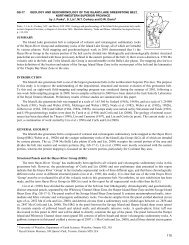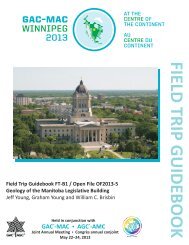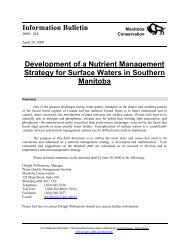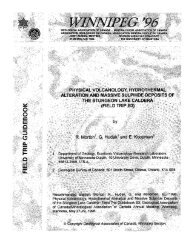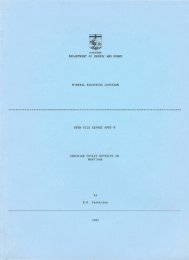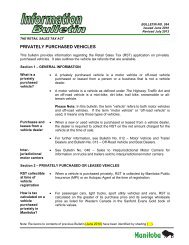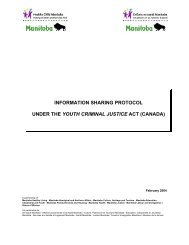Applying Manitoba's Water Policies - Government of Manitoba
Applying Manitoba's Water Policies - Government of Manitoba
Applying Manitoba's Water Policies - Government of Manitoba
Create successful ePaper yourself
Turn your PDF publications into a flip-book with our unique Google optimized e-Paper software.
<strong>Applying</strong> the <strong>Policies</strong>Use & AllocationOverview<strong>Water</strong> is essential for life. We depend on water notonly to maintain our physical well being, but also toenhance or maintain our lifestyle. We use water fordrinking, cleansing, cooking, cooling, heating, growingfood, generating electricity, recreation, waste assimilation,and many other purposes. <strong>Water</strong> is also essentialfor fish and wildlife habitat.Taking all household uses into account,<strong>Manitoba</strong>ns, in 1990, used about 450 litres <strong>of</strong> water perperson per day on the average. This is about 40 percent<strong>of</strong> our total water use, which includes municipal,rural, agricultural, and industrial uses. <strong>Manitoba</strong>nsobtain about 80 percent <strong>of</strong> their water supplies fromsurface sources and the remaining 20 percent fromgroundwater wells.While <strong>Manitoba</strong> has an abundance <strong>of</strong> fresh water,good quality water is not always available where andwhen it is needed, and in the amounts it is needed. Insome areas, water use is approaching the rate <strong>of</strong> supply,and in other areas, water shortages already exist.priority, followed in order by municipal, agricultural,industrial, irrigation, and other uses. The issuance <strong>of</strong> awater rights licence establishes the legal right to use aprescribed amount <strong>of</strong> water over a specified time.<strong>Water</strong> allocation decisions must be made on arational basis and in a consistent, fair, and equitablemanner. Such decisions could be enhanced throughthe application <strong>of</strong> an integrated basin planningapproach, whereby the geographic unit for water planningand decision making is the watershed or basin.There must be more local involvement in decisionmaking. Decisions must ensure that the basin suppliesare sustained, that all existing and potential uses <strong>of</strong>water within the basin are considered, and that theenvironmental and economic consequences <strong>of</strong> variouswater management options are taken into account.As living standards and economic development inthe province are ever increasing, so also is the demandfor water. More communities are installing water supplyand sewerage systems, and industrial and agriculturaldemands continue to grow. <strong>Water</strong> use has beenincreasing at a rate <strong>of</strong> about five percent per year.Some important aquifers and larger streams in southern<strong>Manitoba</strong> are now either fully allocated or nearlyfully allocated. User conflicts are becoming more common.<strong>Water</strong> must be carefully allocated to ensure thatavailable supplies are used in the best possible manner,the ecosystem is supported, and withdrawals do notexceed the rate at which the supplies are naturallyreplenished.The provincial government, through the waterrights licensing system, has the responsibility for allocatingthe use <strong>of</strong> water resources within the province.The water rights licensing system operates under thelegal authority <strong>of</strong> the <strong>Water</strong> Rights Act. The <strong>Water</strong>Rights Act establishes the priorities <strong>of</strong> allocating ourwater resource. Domestic usage is given the highest29



